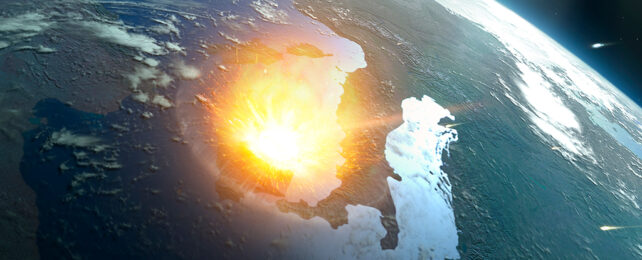Our planet hides its scars well. It's a shame, actually, as evidence of previous asteroid strikes might help us better plan for the next catastrophic impact.
In fact, NASA's Goddard Space Flight Center chief scientist, James Garvin, thinks we might have been misreading traces of some of the more serious asteroid strikes that have occurred within the past million years.
If he's right, the odds of being hit by something nasty could be higher than current estimates predict.
As Garvin put it so eloquently during his presentation at the recent Lunar and Planetary Science Conference: "It would be in the range of serious crap happening."
That most famous of all meteorite impacts – the dinosaur-killing smash that punched a hole into the crust off what is today the Yucatan peninsula some 66 million years ago – stands out in its devastation of life on Earth.
It was a 10-kilometer (about 6-mile) wide behemoth of the likes that hit our planet roughly 100 million years or so.
Yet, far smaller impacts can still shake up enough dust to cast a pall over the planet and potentially lead to years of famine. By some estimates, kilometer-wide asteroids fall to Earth's surface in a blast of heat and dust on average every 600,000 years, give or take.
There's no schedule for these kinds of events, of course, and estimates are only ever as good as the data we use to make our predictions.
While we can scan the skies for evidence of rocks large enough to potentially put us in a world of pain, the geological record is like a ticker-tape of actual meteorite strikes stretching back through time.
Unfortunately this record gets harder to read the further back we look, all thanks to Earth's dynamic winds, water, and tectonics constantly wearing at its surface. Even more recent events can be difficult to interpret through an accumulation of dust and biology.
Garvin and his team used a new catalog of high-resolution satellite images to take a closer look at the weathered remains of some of the largest impact craters formed within the last million years, in an effort to better gauge their true size.
Based on their analysis, a number of these craters feature faint rings beyond what have typically been considered their outer rims, effectively making them larger than previously presumed.
For example, a roughly 12 to 14 kilometer-wide depression in Kazakhstan called Zhaminshin is thought to have been created by a meteorite with a diameter of 200 to 400 meters that hit Earth around 90,000 years ago – the most recent impact to have potentially caused a 'nuclear winter' style event.
However, based on the new analysis, this already large event could have been even more catastrophic, leaving a crater that's actually closer to 30 kilometers across.
The rim diameters of three other large craters have also been recalculated, all doubling or tripling in size. The implications are profound, suggesting kilometer-sized objects are coming down from above every few ten-thousand years.
Though it's good to give old models a good shake-up every now and then, these newly discovered rings might not necessarily be ripples from the impact.
It's possible they might be debris ejected from the strike that's rained back down in a concentrated pattern. Or they might not be anything significant at all – a mere phantom in the data.
Garvin isn't convinced debris fields would still be clear after so many years of weathering and erosion. Yet science doesn't move on the back of a single observation.
It's a hypothesis worthy of debate. While we're busy getting systems in place to try to avoid the sting of a serious asteroid collision, odds are good that Earth's path will be clear for some time to come.
One thing our planet doesn't need is any more scars to hide.
This research was presented at the 2023 Lunar and Planetary Science Conference, held at the Woodlands, north of Houston, Texas.
